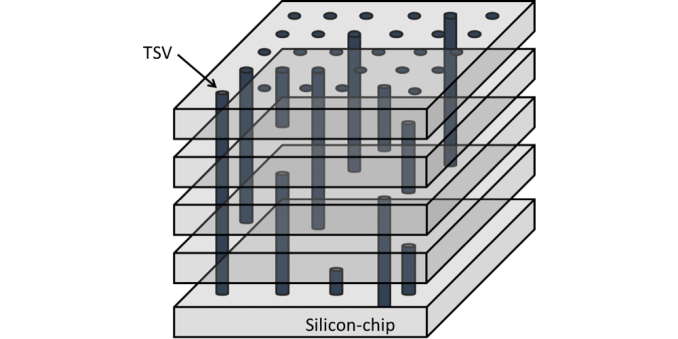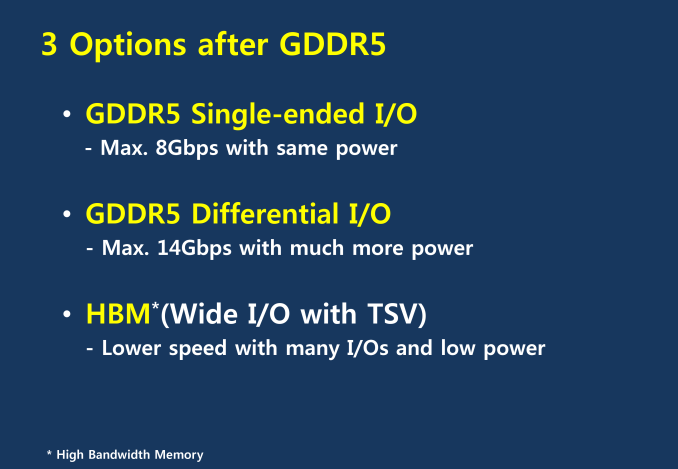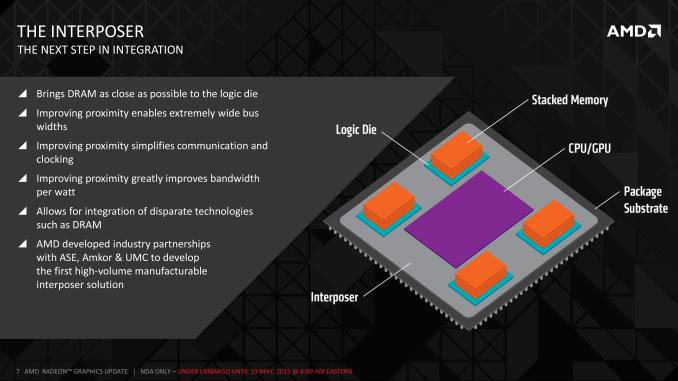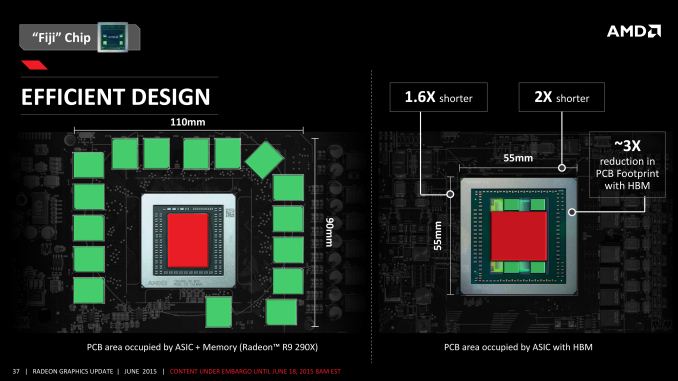The AMD Radeon R9 Fury X Review: Aiming For the Top
by Ryan Smith on July 2, 2015 11:15 AM ESTHigh Bandwidth Memory: Wide & Slow Makes It Fast
Architecturally, the single most notable addition to AMD’s collection of technologies for Fiji is High Bandwidth Memory (HBM). HBM is a next-generation memory standard that will ultimately come to many (if not all) GPUs as the successor to GDDR5. HBM promises a significant increase in memory bandwidth through the use of an ultra-wide, relatively low-clocked memory bus, with die stacked DRAM used to efficiently place the many DRAM dies needed to drive the wide bus.
As part of their pre-Fury X launch activities, AMD briefed the press on HBM back in May, offering virtually every detail one could want on HBM, how it worked, and the benefits of the technology. So for today’s launch there’s relatively little that’s new to say on the subject, but I wanted to quickly recap what we have seen so far.
After several years of GDDR5 – first used on the Radeon HD 4870 in 2008 – HBM comes at a time where GDDR5 is reaching its limits, and companies have been working on its successors. As awesome as GDDR5 is (and it delivers quite a bit of memory bandwidth compared to just about anything else), GDDR5 is already a bit of a power hog and rather complex to implement. GDDR5’s immediate successors would deliver more bandwidth, but they would also exacerbate this problem by drawing even more power and introducing all of the complexity inherent in differential I/O.
So to succeed GDDR5, AMD, Hynix, and the JEDEC as a whole have taken a very different path. Rather than attempting to push a very high bandwidth, narrow(ish) memory bus standard even higher, they have opted to go in the opposite direction with HBM. HBM would significantly back off of the clockspeeds used, but in return it would go wider than GDDR5. Much, much wider.
The ultimate direction that HBM takes us is with a very wide memory bus clocked at a low frequency. For Fiji, AMD has a 4096-bit memory bus clocked at 1000MHz (500MHz DDR). The use of such a wide bus more than offsets the reduction in clockspeed, allowing R9 Fury X to deliver 60% more memory bandwidth than the R9 290X’s GDDR5 implementation.
On the technical side of things, creating HBM has required a few different technologies to be created/improved in order to assemble the final product. The memory bus itself is rather simple (which is in and of itself a benefit), but a 4096-bit wide memory bus is by conventional standards absurdly wide. It requires thousands of contacts and traces, many times more than even 512-bit GDDR5 required (and that was already a lot).
To solve this problem HBM introduces the concept of a silicon interposer. With traditional packaging not up to the challenge of routing so many traces, the one material/package that is capable of hitting the necessary density is fabbed silicon, and thus the silicon interposer. Essentially a partially fabbed chip with just the metal layers but no logic, the interposer is a large chip whose purpose is to allow the ultra-wide 4096-bit memory bus to be created between a GPU and its VRAM, implemented as traces in the metal layers. The interposer itself is not especially complex, however because of the sheer size of the interposer (it needs to be large enough to hold the GPU and VRAM) the interposer brings with it its own challenges.
Meanwhile even though the interposer solves the immediate challenges of implementing a 4096-bit memory bus, the next issue that crops up is where to put the necessary DRAM dies. It takes 16 dies at 256-bits wide each to create the 4096-bit memory bus, and even at its largest size the interposer is still a fraction of the size of the PCB space that traditional GDDR5 chips occupy. As a result the DRAM required for an HBM solution needed to be denser than ever before in a 2D sense.
The solution to that problem was the creation of die-stacking the DRAM. If you can’t go wider, go taller, which is exactly what has happened with HBM. In HBM1 the stacks can go up to 4 dies high, allowing the necessary 16 dies to be reduced to a far more easily managed 4 stacks. With a base logic die at the bottom of each stack to serve as the PHY between the DRAM and the GPU (technically making the complete stack 5 dies), stacking the DRAM is what makes it practical to put so much RAM so close to the GPU.
The final new piece of technology in HBM comes in the die stacks themselves. With the need to route a 1024-bit memory bus through 4 memory dies, traditional package-on-package wire bonding is no longer sufficient. To connect up the memory dies, much like the interposer itself, a newer, denser connectivity method is required.

TSVs. Image Courtesy The International Center for Materials Nanoarchitectonics
To solve that problem, the HBM memory stacks implement Through-Silicon Vias, which involves running the vias straight through silicon devices in order to connect layers. The end result is something vaguely akin to DRAM dies surface mounted on top of each other via microbumps, but with the ability to communicate through the layers. From a manufacturing standpoint, between the silicon interposer and TSVs, TSVs are the more difficult technology to master as it essentially combines all the challenges of DRAM fabbing with the challenges of stacking those DRAM dies on top of each other.
Combined together as a single product, HBM is the next generation of GPU memory technology thanks to the fact that it offers multiple benefits over GDDR5. Memory bandwidth of course is a big part, but of similar significance is the power savings from HBM. The greatly simplified memory bus requires far less power be spent on the bus itself, and as a result the amount of power spent on VRAM is reduced. As we discussed earlier AMD is looking at a 20-30W VRAM power savings on R9 Fury X over R9 290X.
The third major benefit of HBM over GDDR5 goes back to the size benefits discussed earlier. Because all of the VRAM in an HBM setup fits on-chip, this frees up a significant amount of space. The R9 Fury X PCB is 3” shorter than the R9 290X PCB, and the bulk of these savings come from the space savings enjoyed by using HBM. Along with the immediate space savings of 4 small HBM stacks as opposed to 16 GDDR5 memory chips, AMD also gets to cut down on the amount of power delivery circuitry needed to support the VRAM, further saving space and some bill of material costs in the process.
On the downside though, it is the bill of materials that is the biggest question hanging over HBM. Since HBM introduces several new technologies there are any number of things that can go wrong, all of which can drive up the costs. Of particular concern is the yield on the HBM memory stacks, as the TSV technology is especially intricate and said to be difficult to master. The interposer on the other hand is simpler, but it still represents something that has never been done before, and AMD admits upfront that the manufacturing facilities being used to create the interposer are old 65nm lines originally used for full chip production. So while the interposer does not approach the cost of a full logic chip, there is still the matter of the existing manufacturing lines being sub-optimal for high-volume low-cost production. Meanwhile AMD does get to enjoy some cost savings as well – the HBM PHYs are certainly much easier to implement than GDDR5 PHYs on Fiji itself, and the overall package is cheaper since it doesn't have GDDR5 memory running through it – though it's unlikely that these savings outweigh the other costs of implementing HBM at this time.
Ultimately AMD Is not willing to discuss HBM costs or yields at this time. Practically speaking it’s not a consumer matter – what matters to video card buyers is the $650 price tag on the R9 Fury X – and from a trade secrets perspective AMD is loath to share too much about what they have learned since they are the first HBM customer and want to enjoy as much of that advantage as is possible. At this point I feel it’s a safe bet that the 4GB HBM implementation on Fiji is costing AMD more than the 4GB (or even 8GB) GDDR5 implementations on Hawaii cards, but beyond that it’s difficult to say much more on costs.
That said, regardless of what the costs are now, HBM will be the future for AMD, and for the GPU industry as a whole. NVIDIA has already committed to using HBM technology for their high-end Pascal GPU in 2016, so AMD will be joined by other parties next year. Meanwhile AMD has much grander plans for HBM, intending to bring it to other products as costs allow. HBM on lower-priced GPUs is practically a given, meanwhile equipping AMD’s APUs with HBM would solve one of the greatest problems AMD faces today on the iGPU performance front, which is that 128-bit DDR3 bottlenecks the iGPU on their Kaveri APUs. AMD could build a better iGPU, if only they had more bandwidth to feed it with. This is a problem HBM is well positioned to solve.
Finally, at the end of the day what can’t be perfectly captured in words is AMD’s pride in being the first to roll out HBM. AMD was the first (and only) company to support GDDR4, they were the first company to support GDDR5, and now they are the first company to support HBM. The company has put significant resources into helping to develop the technology alongside Hynix, UMC, ASE, Amkor, and the JEDEC, and they see the launch of the technology as a testament to their engineering capabilities.
Furthermore they also see the fact that they are first as being a significant advantage going forward, as it means they have a generational advantage on arch-rival NVIDIA in implementing the technology. Case in point, NVIDIA’s first GDDR5 memory controller was by all accounts an underperformer, and it wasn’t until their second generation GDDR5 controller for Kepler that NVIDIA was able to hit (and even exceed) their aimed for memory clockspeeds. Admittedly this comes down to AMD hoping NVIDIA is going to stumble here, but at the end of the day the company is optimistic that all of their work is going to allow them to get more out of HBM than NVIDIA will be able to.














458 Comments
View All Comments
Scali - Tuesday, July 7, 2015 - link
Even better, there are various vendors that sell a short version of the GTX970 (including Asus and Gigabyte for example), so it can take on the Nano card directly, as a good choice for a mini-ITX based HTPC.And unlike the Nano, the 970 DOES have HDMI 2.0, so you can get 4k 60 Hz on your TV.
Oxford Guy - Thursday, July 9, 2015 - link
28 GB/s + XOR contention is fast performance indeed, at half the speed of a midrange card from 2007.Gothmoth - Monday, July 6, 2015 - link
so in short another BULLDOZER.... :-(after all the hype not enough and too late.
i agree the card is not bad.. but after all the HYPE it IS a disappointment.
OC results are terrible... and AMD said it will be an overclockers dream.
add to that that i read many complains about the noisy watercooler (yes for retail versions not early preview versions).
iamserious - Monday, July 6, 2015 - link
It looks ugly. Loliamserious - Monday, July 6, 2015 - link
Also. I understand it's a little early but I thought this card was supposed to blow the GTX 980Ti out of the water with it's new memory. The performance to price ratio is decent but I was expecting a bit larger jump in performance increase. Perhaps with the driver updates things will change.Scali - Tuesday, July 7, 2015 - link
Hum, unless I missed it, I didn't see any mention of the fact that this card only supports DX12 level 12_0, where nVidia's 9xx-series support 12_1.That, combined with the lack of HDMI 2.0 and the 4 GB limit, makes the Fury X into a poor choice for the longer term. It is a dated architecture, pumped up to higher performance levels.
FMinus - Tuesday, July 7, 2015 - link
Whilst it's beyond me why they skimped on HDMI 2.0 - there's adapters if you really want to run this card on a TV. It's not such a huge drama tho, the cards will drive DP monitors in the vast majority, so, I'm much more sad at the missing DVI out.Scali - Wednesday, July 8, 2015 - link
I think the reason why there's no HDMI 2.0 is simple: they re-used their dated architecture, and did not spend time on developing new features, such as HDMI 2.0 or 12_1 support.With nVidia already having this technology on the market for more than half a year, AMD is starting to drop behind. They were losing sales to nVidia, and their new offerings don't seem compelling enough to regain their lost marketshare, hence their profits will be limited, hence their investment in R&D for the next generation will be limited. Which is a problem, since they need to invest more just to get where nVidia already is.
It looks like they may be going down the same downward spiral as their CPU division.
sa365 - Tuesday, July 7, 2015 - link
Well at least AMD aren't cheating by allowing the driver to remove AF despite what settings are selected in game. Just so they can win benchmarks.How about some fair, like for like benchmarking and see where these cards really stand.
FourEyedGeek - Tuesday, July 7, 2015 - link
As for the consoles having 8 GB of RAM, not only is that shared, but the OS uses 3 GB to 3.5 GB, meaning there is only a max of 5 GB for the games on those consoles. A typical PC being used with this card will have 8 to 16 GB plus the 4 GB on the card. Giving a total of 12 GB to 20 GB.In all honesty at 4K resolutions, how important is Anti-Aliasing on the eye? I can't imagine it being necessary at all, let alone 4xMSAA.